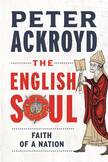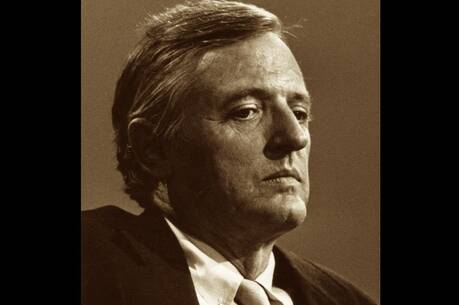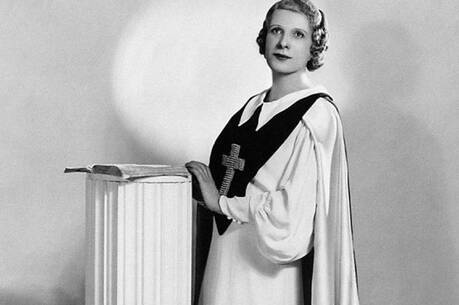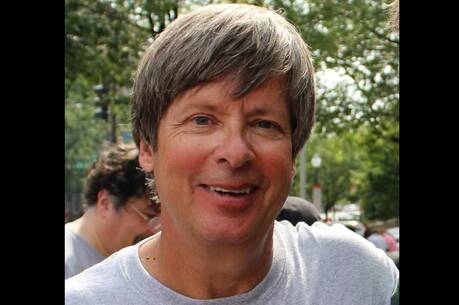
Review: Eamon Duffy on Peter Ackroyd’s ‘The English Soul’
Christianity, Peter Ackroyd declares at the outset of The English Soul: Faith of a Nation, has been “the anchoring and defining doctrine of England” and “the reflection, perhaps the embodiment of the English soul.” Other faiths and the sometimes very substantial communities who profess them—Judaism, Islam, Hinduism—have an important place in any modern understanding of that English soul, but, not being “of native origin or of native inspiration,” they “did not create it.”
Such sentiments embody obvious enough historical truisms, but in the hands of populists like Hungary’s Viktor Orban, attempts to identify the “soul” of a nation can all too easily be weaponized against what are perceived as problematic minorities. Ackroyd is aware of that danger and makes the necessary caveats. He nevertheless presents his book as an attempt to characterize the “spirit and nature of English Christianity…as it has developed over the last 1,400 years.”
But that is not in fact the book he has written. This book is largely a study of some notable figures in Protestant England.
Christianity has been the predominant faith of mainland Britain for a millennium and a half. In the sixth century, a flourishing Romano-British church was almost overwhelmed by a tide of pagan Scandinavian and Germanic “Saxon” invaders. By the seventh century, the invaders turned settlers themselves were increasingly abandoning their harsh northern pantheon for the milder and literate pieties of Christianity, and by the eighth century, English missionaries were launching missions to convert the rest of pagan northern Europe.
Over the next eight centuries, England developed a dense network of Christian mini-territories, the parishes, whose communal identity and church buildings were the setting for the landmark events of the people’s lives—birth, marriage and death—and in whose material fabric the hopes, aspirations and beliefs of successive generations were sanctified, embodied and inscribed. Twenty-six cathedrals and more than 13,000 English parish churches survive from the English middle ages, their architecture, wall-paintings, stained-glass windows, gravestones and monumental brasses constituting a vast and eloquent material archive of the English soul over its formative millennium.
As literacy increased, lay men and women acquired “Books of Hours” to help them pray, which were handed on through generations, acquiring family notes and added devotions in margins and blank pages that traced the changing patterns of belief and practice. From those centuries, too, tens of thousands of medieval wills survive, in whose religious provisions lords and ladies, merchants, shopkeepers, farmers and artisans expressed their beliefs and hopes for this world and the next.
For those thousand years, Christian England—the England of Alfred the Great and Henry V, of Geoffrey Chaucer and William Langland—was, like the rest of Europe, fundamentally Catholic. That meant it was sacramental, focused especially on belief in the living presence of Christ in the Mass and in a material world transparent to the sacred and penetrated by spiritual presences, the suppliant dead and the triumphant angels and saints.
England itself was crisscrossed by pilgrimage routes to healing shrines: Becket at Canterbury, the Virgin Mary at Walsingham, St. Wilfred at York, St. Chad at Durham, St. Etheldreda at Ely, St. Edmund at Bury, and hundreds, probably thousands, of minor local shrines where, it was believed, healing and comfort for troubled souls and ailing bodies were to be found.
None of this, evidently, rates Ackroyd’s consideration, and the possibility that its forcible and sudden suppression by successive Tudor monarchs—the outlawing of prayer for the dead and the sacrifice of the Mass, the destruction of the shrines and the abolition of monastic life, “bare ruined choirs where late the sweet birds sang”—might have constituted a trauma for the English soul is never even mooted.
England’s Catholic millennium is dealt with in just three of the book’s 23 chapters, and they focus exclusively on exceptional writers about religion: the seventh-century monk and biblical commentator Bede, here treated primarily as a historian; then, leaping over the next seven centuries, a cluster of 14th-century mystical writers, especially two East Anglian women, the anchoress Julian of Norwich and the wandering ex-housewife Margery Kempe; and the acrimonious Oxford philosopher, theologian and heresiarch John Wycliffe, whose principal contribution to English religion was, in Ackroyd’s view, to help “build a fortress in England against the power of Rome and Catholic Europe.”
The rest of Ackroyd’s book follows a well-worn (and now widely questioned) Protestant triumphalist narrative, in which the royal religious revolution that forcibly swept away a thousand years of Catholicism and replaced it with what was increasingly a religion not of sign, symbol and sacrament, but of the Book, was seen as the assertion of a fundamentally English religious identity over an alien foreign imposition.
So Ackroyd, though aware of the limited appeal of Wycliffe’s attack on some of the fundamentals of Catholic belief in the 14th century, nevertheless claims that he “laid bare the root cause of native discontent with the Roman faith,” where the word “Roman” suggests that the faith in question, which had been normative for eight centuries, was not really “English.”
In the same way he asserts that on the eve of the Reformation, “the educated laity were dismissive of friars, pluralists and bishops” and “there were doubts about Catholic doctrine.” Yet there is overwhelming historical evidence that in the century before the break with Rome, those very same laypeople were pouring money into rebuilding and beautifying their parish churches and financing legions of stipendiary guild and chantry priests (the future Protestant Bible translator William Tyndale among them) to provide the Catholic ceremonies and teach the beliefs about which Ackroyd supposes they were having “doubts.”
For the last 30 years, historians of the English Reformation have been calling into question the received narrative of an unpopular and decadent medieval church that was easily overturned, and the rapid adoption of a more congenial Protestantism, that underlies Ackroyd’s story. A “Guide to Further Reading” in The English Soul significantly contains no works representing this more recent research and interpretation. From his account of Wycliffe onward, the Catholicism that nourished England’s soul for a thousand years simply disappears from his story—to reappear, only briefly and without context, in chapters on John Henry Newman and G. K. Chesterton.
As a consequence, Ackroyd presents as enduring characteristics of English religion features that were in fact the consequence of the Reformation upheaval itself. “Ambiguity and compromise” he claims, “were part of the English temper: doctrinal purity was not.” But this is manifestly untrue.
Wycliffe himself was notoriously argumentative, and medieval England produced many distinguished scholastic theologians, fully engaged in the doctrinal and philosophical debates that were the stuff of university theology. Confining oneself to the Archbishops of Canterbury alone, one can point to Stephen Langton, Robert Kilwardby, John Peckham and William Bradwardine. These English churchmen and theologians were frequently sticklers for orthodoxy, as the sometimes lethal 14th- and 15th-century campaigns against the Lollard heresy demonstrated.
Some English anti-heretical writings gained European status as classic statements of orthodox Catholic doctrine. The 15th-century Carmelite theologian Thomas Netter’s huge anti-Lollard compendium, the Doctrinale Fidei Ecclesiae, became a standard European reference work against heresy, and the anti-Lutheran treatises of that archetypical Yorkshireman, John Fisher, became the basis of the European Counter-Reformation’s polemic against Protestantism.
All that changed when Henry VIII and his son Edward VI imposed progressively more Protestant settlements on bishops and clergy, many of whom still retained Catholic beliefs. Doctrinal unanimity became a thing of the past, never to be regained, and ambiguity and compromise became essential survival mechanisms for those wishing to retain their jobs, and even on occasion their heads.
Doctrinal ambiguity, or at any rate self-conscious moderation, has remained a feature of the modern Anglican Church, and is often perceived as its defining virtue. But many of the historical figures featured in this book would have despised religious moderation as cowardice and apostasy, not least the gallery of “sectaries” who rejected the Established Church altogether: Elizabethan separatists like Robert Browne and Henry Barrow, Baptists like John Bunyan, Quakers like George Fox.
Ackroyd is an accomplished writer who has often written compellingly about the English past. But he is not at his best in this book, a sometimes dutiful catalog of major and some very minor religious figures, lacking a convincing unifying theme. Anyone looking for a key to the English soul must look elsewhere.










